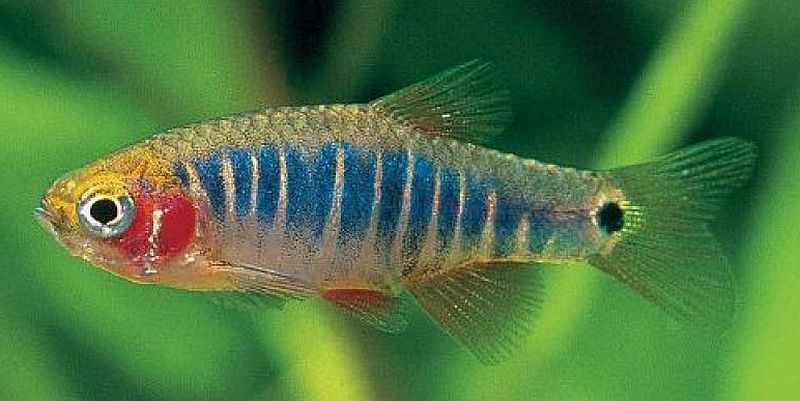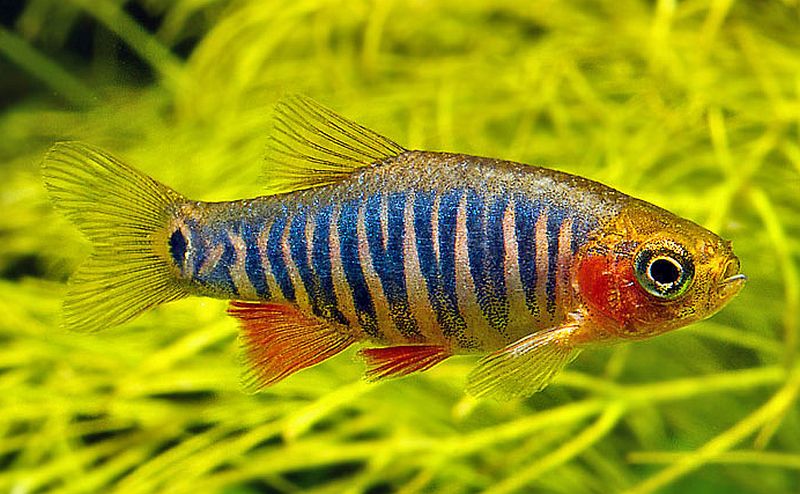The Emerald Dwarf Rasbora (Microrasbora erythromicron) is found in a mountain lake situated in the western Shan State of Myanmar (Burma) called Lake Inle.
The Emerald Dwarf Rasbora has a pale copper head, a pinkish orange body with up to 15 emerald green bars along its side and a single black spot, rimmed in copper, at the base of their caudal fin.
The fins of the males have a reddish orange tinge, while the fins of females are clear and less colorful. The relatively high body of the fish gives it a stocky appearance. Their bright fins set off the emerald green body colors and give the fish a glowing look in the aquarium. Males are more intensely colored and slightly smaller than females.
The Emerald Dwarf Rasbora is listed in the genus Microrasbora, but that will likely change because of the discovery that they are more closely related to danios than rasboras. It is a peaceful, timid, active fish that can be kept with like sized danios, rasboras, devarios, and smaller barbs but their colors are brightest and they are most sociable in shoals of at least 6-8 of their own species.
A 10-15 gallon tank would be perfect for a small school of about 15 to 20 fish with a ratio of 1 male to 3 females. You might be tempted to add other small fish, but try to avoid this. These little guys will do very well by themselves, and they might even spawn in this tank. With other fish, you will probably never see a spawning, or if they do spawn, you’ll never see the fry.
The Emerald Dwarf Rasbora does best in moderately hard (150 ppm to 300 ppm total hardness) water that has a pH of 7.2 to 7.4, and a temperature of 72 to 74 degrees F. To mimic their natural mountain lake habitat, they need frequent water changes and adequate filtration to keep their water as clean and pure as possible. Any waste buildup will cause these little fish to quickly deterioriate and die if not corrected.
In an aquarium environment, Emerald Dwarf Rasboras will do just fine in a densely planted 10 to 15 gallon tank with plenty of swimming area. They do best in a single species tank in small schools. When housed with other small species, they seldom breed and may get bullied.
Emerald Dwarf Rasboras will breed freely and continuously in an aquarium with the water parameters noted above. Females will lay several eggs daily until spawning is completed, but because they seem to enjoy eating their eggs and fry it is a good idea to breed the fish in a separate breeding tank.
To do this, separate the males from the females and feed them an exclusive diet of live foods for a week or two. The fish should be about an inch long and have good coloration when properly conditioned. When the females plumps up, add them to the breeding tank and towards evening before the lights are out, add the males to the tank. The tank should have several breeding mops or clumps of Java Moss for the females to deposit their eggs. Usually, spawning will commence the following morning and continue for several days. Check the spawning mops or Java Moss daily for eggs and replace them to a “hatching tank” when eggs are present. After a week or so, spawning should be completed and the fish can be relocated to their original tank.
The “hatching tank” should have a fine air stone in the tank for water circulation but no filter for the first couple of weeks. After that, a seeded sponge filter can be used. The clear eggs will hatch out in 72 hours at a temperature of 72 degrees F. at which time the tiny fry can be seen lying on the bottom of the tank. Do not feed the fry until they are totally free swimming. This can take an additional week or two.
Add a clump of clean Java Moss to the fry tank to help purify the water, give the fry a place to hide, and provide them with microfauna to feed on. Feed infusoria, paramecium, Cyclops, or powdered or liquid commercial fry foods to the tank daily until the fry show sign of growth. When using commercially prepared foods, several small feedings should be made and uneaten food should be removed from the tank. Small daily water changes with water from the main tank should be made to maintain water quality.
After about a week, start feeding newly hatched baby brine shrimp to the fry along with the infusoria or prepared foods until all the fry are eating them. This can take up to a week. Then stop feeding infusoria and add microworms to their diet of brine shrimp until they get to be about 3/8″ long (about 3 weeks after hatching). After about 6 to8 weeks, the fish can be slowly added to the main tank.
The parents will not eat the fry once they cannot fit them into their mouths, they simply ignore them.
Adult Emerald Dwarf Rasboras will eagerly accept live, frozen or freeze dried, brine shrimp, mosquito larvae, , daphnia, bloodworms or micro pellets
.
The Emerald Dwarf Rasbora an uncommon find for tropical fish keeping enthusiasts and when available are usually 1″ in or less in size.
Minimum Tank Size: 10 gallons
Care Level: Moderate
Temperament: Peaceful
Aquarium Hardiness: Moderately Hardy
Water Conditions: 70-77° F, 10-25 °d, pH 7.0-7.5
Max. Size: 1.5″
Color Form: Iridescent copper, green, blue
Diet: Omnivore
Compatibility: Single species tank
Origin: Lake Inle, Myanmar
Family: Cyprinidae
Lifespan: 3-5 years
Aquarist Experience Level: Beginner to advanced




